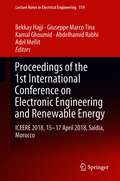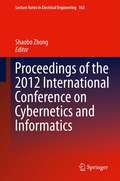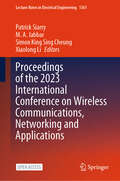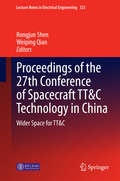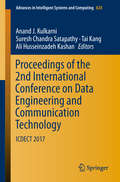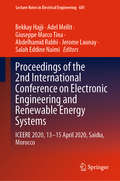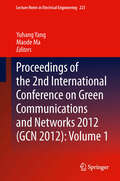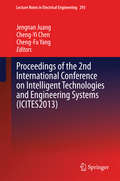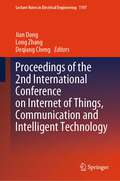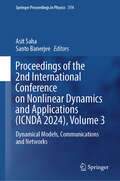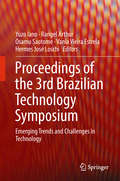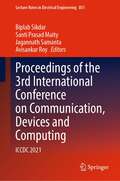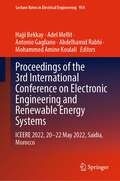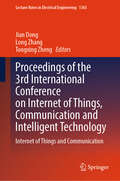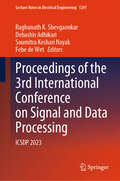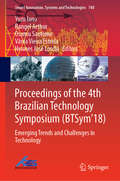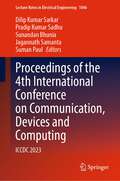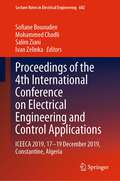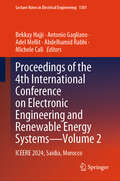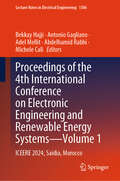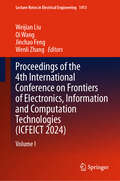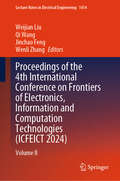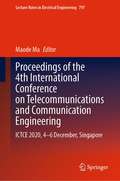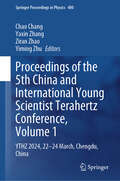- Table View
- List View
Proceedings of the 1st International Conference on Electronic Engineering and Renewable Energy: ICEERE 2018, 15-17 April 2018, Saidia, Morocco (Lecture Notes in Electrical Engineering #519)
by Bekkay Hajji Giuseppe Marco Tina Kamal Ghoumid Abdelhamid Rabhi Adel MellitThe proceedings present a selection of refereed papers presented at the 1st International Conference on Electronic Engineering and Renewable Energy (ICEERE 2018) held during 15-17 April 2018, Saidi, Morocco.The contributions from electrical engineers and experts highlight key issues and developments essential to the multifaceted field of electrical engineering systems and seek to address multidisciplinary challenges in Information and Communication Technologies. The book has a special focus on energy challenges for developing the Euro-Mediterranean regions through new renewable energy technologies in the agricultural and rural areas.The book is intended for academia, including graduate students, experienced researchers and industrial practitioners working in the fields of Electronic Engineering and Renewable Energy.
Proceedings of the 2012 International Conference on Cybernetics and Informatics
by Shaobo ZhongProceedings of the International Conference on Cybernetics and Informatics (ICCI 2012) covers the hybridization in control, computer, information, communications and applications. ICCI 2012 held on September 21-23, 2012, in Chongqing, China, is organized by Chongqing Normal University, Chongqing University, Nanyang Technological University, Shanghai Jiao Tong University, Hunan Institute of Engineering, Beijing University, and sponsored by National Natural Science Foundation of China (NSFC). This two volume publication includes selected papers from the ICCI 2012. Covering the latest research advances in the area of computer, informatics, cybernetics and applications, which mainly includes the computer, information, control, communications technologies and applications.
Proceedings of the 2015 International Conference on Communications, Signal Processing, and Systems
by Qilian Liang Wei Wang Jiasong Mu Baoju ZhangThis book brings together papers presented at the 4th International Conference on Communications, Signal Processing, and Systems, which provides a venue to disseminate the latest developments and to discuss the interactions and links between these multidisciplinary fields. Spanning topics ranging from Communications, Signal Processing and Systems, this book is aimed at undergraduate and graduate students in Electrical Engineering, Computer Science and Mathematics, researchers and engineers from academia and industry as well as government employees (such as NSF, DOD, DOE, etc).
Proceedings of the 2023 International Conference on Wireless Communications, Networking and Applications (Lecture Notes in Electrical Engineering #1361)
by Patrick Siarry Xiaolong Li M. A. Jabbar Simon King Sing CheungThis open access book includes original, peer-reviewed research papers from the 2023 International Conference on Wireless Communications, Networking and Applications (WCNA 2023), held in Shenzhen, Guangdong, China, from December 29 to 31, 2023. The topics covered include but are not limited to: Wireless Communications; Devices, Tools, and Techniques for WSN and Other Wireless Networks; Wireless Sensor Networks; Internet of Things (IoT); AI; Signal Processing; and Sustainable Pervasive WSN Applications. The papers showcased here share the latest findings on Wireless Communications, Networking and Applications, making the book a valuable asset for researchers, scientists, scholars, engineers and students from the universities all around the world and the industry.
Proceedings of the 26th Conference of Spacecraft TT&C Technology in China
by Weiping Qian Rongjun Shen'Proceedings of the 26th Conference of Spacecraft TT&C Technology in China' collects selected papers from the 26th Conference of Spacecraft TT&C Technology in China held in Nanjing on October 16-19, 2012. The book features state-of-the-art studies on spacecraft TT&C in China with the theme of "Shared and Flexible TT&C Systems". The selected works can help promote the technologies in standardization, informatization, communication networks and intelligence. Researchers and engineers in the field of aerospace engineering and communication engineering can benefit from the book. SHEN Rongjun is the Academician of Chinese Academy of Engineering; QIAN Weiping is the Director General of Beijing Institute of Tracking and Telecommunications Technology.
Proceedings of the 2nd International Conference on Data Engineering and Communication Technology: ICDECT 2017 (Advances in Intelligent Systems and Computing #828)
by Suresh Chandra Satapathy Anand J. Kulkarni Tai Kang Ali Husseinzadeh KashanThis book features research work presented at the 2nd International Conference on Data Engineering and Communication Technology (ICDECT) held on December 15–16, 2017 at Symbiosis International University, Pune, Maharashtra, India. It discusses advanced, multi-disciplinary research into smart computing, information systems and electronic systems, focusing on innovation paradigms in system knowledge, intelligence and sustainability that can be applied to provide feasible solutions to varied problems in society, the environment and industry. It also addresses the deployment of emerging computational and knowledge transfer approaches, optimizing solutions in a variety of disciplines of computer science and electronics engineering.
Proceedings of the 2nd International Conference on Electronic Engineering and Renewable Energy Systems: ICEERE 2020, 13-15 April 2020, Saidia, Morocco (Lecture Notes in Electrical Engineering #681)
by Bekkay Hajji Giuseppe Marco Tina Abdelhamid Rabhi Adel Mellit Jerome Launay Salah Eddine NaimiThis book includes papers presented at the Second International Conference on Electronic Engineering and Renewable Energy (ICEERE 2020), which focus on the application of artificial intelligence techniques, emerging technology and the Internet of things in electrical and renewable energy systems, including hybrid systems, micro-grids, networking, smart health applications, smart grid, mechatronics and electric vehicles. It particularly focuses on new renewable energy technologies for agricultural and rural areas to promote the development of the Euro-Mediterranean region. Given its scope, the book is of interest to graduate students, researchers and practicing engineers working in the fields of electronic engineering and renewable energy.
Proceedings of the 2nd International Conference on Green Communications and Networks 2012: Volume 3 (GCN #2012)
by Maode Ma Yuhang YangThe objective of the 2nd International Conference on Green Communications and Networks 2012 (GCN 2012) is to facilitate an exchange of information on best practices for the latest research advances in the area of communications, networks and intelligence applications. These mainly involve computer science and engineering, informatics, communications and control, electrical engineering, information computing, and business intelligence and management. Proceedings of the 2nd International Conference on Green Communications and Networks 2012 (GCN 2012) will focus on green information technology and applications, which will provide in-depth insights for engineers and scientists in academia, industry, and government. The book addresses the most innovative research developments including technical challenges, social and economic issues, and presents and discusses the authors' ideas, experiences, findings, and current projects on all aspects of advanced green information technology and applications. Yuhang Yang is a professor at the Department of Electronic Engineering, Shanghai Jiao Tong University. Maode Ma is an associate professor at the School of Electrical & Electronic Engineering, Nanyang Technological University.
Proceedings of the 2nd International Conference on Intelligent Technologies and Engineering Systems (Lecture Notes in Electrical Engineering #293)
by Jengnan Juang Cheng-Yi Chen Cheng-Fu YangThis book includes the original, peer reviewed research papers from the conference, Proceedings of the 2nd International Conference on Intelligent Technologies and Engineering Systems (ICITES2013), which took place on December 12-14, 2013 at Cheng Shiu University in Kaohsiung, Taiwan. Topics covered include: laser technology, wireless and mobile networking, lean and agile manufacturing, speech processing, microwave dielectrics, intelligent circuits and systems, 3D graphics, communications and structure dynamics and control.
Proceedings of the 2nd International Conference on Internet of Things, Communication and Intelligent Technology (Lecture Notes in Electrical Engineering #1197)
by Long Zhang Jian Dong Deqiang ChengThis conference discussed the application of communication and IoT engineering in the era of smart technologies from the perspective of disciplinary integration, combining the theory and relevant algorithms of IoT and smart technologies. The book encompasses the entire spectrum of IoT solutions, from IoT to cybersecurity. It explores communication systems, including sixth generation (6G) mobile, D2D and M2M communications. It also focuses on intelligent technologies, especially information systems modeling and simulation. In addition, it explores the areas of pervasive computing, distributed computing, high performance computing, pervasive and mobile computing, and cloud computing.
Proceedings of the 2nd International Conference on Nonlinear Dynamics and Applications: Dynamical Models, Communications and Networks (Springer Proceedings in Physics #314)
by Santo Banerjee Asit SahaThis book covers the latest advancements and applications of nonlinear dynamics in various fields of science and engineering, presenting a curated selection of peer-reviewed contributions at the 2nd International Conference on Nonlinear Dynamics and Applications (ICNDA 2024) at Sikkim Manipal Institute of Technology (SMIT). Organized by the Department of Mathematics, SMIT, SMU, this international conference provides a platform for scientists, researchers, and inventors to share their findings and exchange ideas in the ever-evolving field of nonlinear dynamics. This book comprises three volumes. Volume 3 focuses on graphs, networks, and communications. It covers topics such as optimization in control and neural systems; machine learning for signal analysis and classification; graph theory applications in science and engineering; analysis of wavelets and transforms in signal processing; and semiconductor devices and nanomaterials.
Proceedings of the 3rd Brazilian Technology Symposium: Emerging Trends And Challenges In Technology
by Yuzo Iano Rangel Arthur Osamu Saotome Vania Vieira Estrela Hermes José LoschiThis book presents the proceedings of the 3rd Brazilian Technology Symposium (BTSym), which is a multi/trans/interdisciplinary event offering an excellent forum for presentations and discussions of the latest scientific and technological developments in various areas of research, with an emphasis on smart design and future technologies. It brings together researchers, students and professionals from the industrial and academic sectors to discuss current technological issues. Among the main topics covered in this book, we can highlight Artificial Neural Networks, Computational Vision, Security Applications, Web Tool, Cloud Environment, Network Functions Virtualization, Software-Defined Networks, IoT, Residential Automation, Data Acquisition, Industry 4.0, Cyber-Physical Systems, Digital Image Processing, Infrared Images, Patters Recognition, Digital Video Processing, Precoding, Embedded Systems, Machine Learning, Remote Sensing, Wireless Sensor Network, Heterogeneous Networks, Unmanned Ground Vehicle, Unmanned Aerial System, Security, Surveillance, Traffic Analysis, Digital Television, 5G, Image Filter, Partial Differential Equation, Smoothing Filters, Voltage Controlled Ring Oscillator, Difference Amplifier, Photocatalysis, Photodegradation, Cosmic Radiation Effects, Radiation Hardening Techniques, Surface Electromyography, Sickle cell disease methodology, MicroRNAs, Image Processing Venipuncture, Cognitive Ergonomics, Ecosystem services, Environmental, Power Generation, Ecosystem services valuation, Solid Waste and University Extension.
Proceedings of the 3rd International Conference on Communication, Devices and Computing: ICCDC 2021 (Lecture Notes in Electrical Engineering #851)
by Biplab Sikdar Santi Prasad Maity Jagannath Samanta Avisankar RoyThis book provides insights into the 3rd International Conference on Communication, Devices and Computing (ICCDC 2021), which was held in Haldia, India, on August 16–18, 2021. It covers new ideas, applications, and the experiences of research engineers, scientists, industrialists, scholars, and students from around the globe. The proceedings highlight cutting-edge research on communication, electronic devices, and computing and address diverse areas such as 5G communication, spread spectrum systems, wireless sensor networks, and signal processing for secure communication, error control coding, printed antennas, analysis of wireless networks, antenna array systems, analog and digital signal processing for communication systems, frequency selective surfaces, radar communication, and substrate integrated waveguide and microwave passive components, which are key to state-of-the-art innovations in communication technologies.
Proceedings of the 3rd International Conference on Electronic Engineering and Renewable Energy Systems: ICEERE 2022, 20 -22 May 2022, Saidia, Morocco (Lecture Notes in Electrical Engineering #954)
by Abdelhamid Rabhi Adel Mellit Hajji Bekkay Antonio Gagliano Mohammed Amine KoulaliThis book includes papers presented at the 3rd International Conference on Electronic Engineering and Renewable Energy (ICEERE 2022), which focus on the application of artificial intelligence techniques, emerging technology and the Internet of things in electrical and renewable energy systems, including hybrid systems, micro-grids, networking, smart health applications, smart grid, mechatronics and electric vehicles. It particularly focuses on new renewable energy technologies for agricultural and rural areas to promote the development of the Euro-Mediterranean region. Given its scope, the book is of interest to graduate students, researchers and practicing engineers working in the fields of electronic engineering and renewable energy.
Proceedings of the 3rd International Conference on Internet of Things, Communication and Intelligent Technology: Internet of Things and Communication (Lecture Notes in Electrical Engineering #1365)
by Long Zhang Jian Dong Tongxing ZhengAs the Internet of Things (IoT) continues to evolve and integrate more deeply into various industries, the IoTCIT 2024 conference is emerging as a critical platform for sharing insights and advancements in IoT and its symbiotic technologies. This year, we are broadening our horizons to include sophisticated communication systems, IoT applications, and the burgeoning field of intelligent technologies. The proceedings will feature a robust selection of papers spotlighting the latest developments in both fundamental and applied aspects of communications. From the intricacies of communication signal processing to the frontiers of next-generation (6G) mobile communications, and the critical role of smart grid and power line communication systems, attendees will gain a comprehensive understanding of the current state and future directions of communication technologies. This exploration will not only cover traditional wired and wireless communications but will also extend to emerging domains such as radio frequency and microwave communications, satellite communications, and the pivotal area of green communication systems. On the IoT front, the proceedings of IoTCIT 2024 will delve into the expansive world of wireless sensor and actuator networks, vehicle networks, and the integration of IoT with big data, among other topics. As intelligent technologies, transformative areas such as modeling and simulation of information systems, distributed computing, ubiquitous computing, and cloud computing are discussed. These discussions are set to cover both theoretical frameworks and practical applications, aiming to bridge the gap between academic research and industry solutions. This convergence of technology and discourse will attract participants, from students to professionals and researchers, and provide more practical guidance and support for them. This book will serve as a reference for students, professionals, and researchers to further understand and apply IoT and intelligent technologies.
Proceedings of the 3rd International Conference on Signal and Data Processing: ICSDP 2023 (Lecture Notes in Electrical Engineering #1297)
by Debashis Adhikari Raghunath K. Shevgaonkar Soumitra Keshari Nayak Febe De WetThis volume comprises the select proceedings of the 3rd International Conference on Signal & Data Processing - ICSDP 2023. The contents focus on the latest research and developments in the field of artificial intelligence & machine learning, Internet of Things (IoT), cybernetics, advanced communication systems, VLSI embedded systems, power electronics and automation, MEMS/ nanotechnology, renewable energy, bioinformatics, data acquisition and mining, antenna & RF systems, power systems, biomedical engineering, aerospace & navigation. This volume will prove to be a valuable resource for those in academia and industry.
Proceedings of the 4th Brazilian Technology Symposium: Emerging Trends and Challenges in Technology (Smart Innovation, Systems and Technologies #140)
by Yuzo Iano Rangel Arthur Osamu Saotome Hermes José Loschi Vânia Vieira EstrelaThis book presents the Proceedings of The 4th Brazilian Technology Symposium (BTSym'18). Part I of the book discusses current technological issues on Systems Engineering, Mathematics and Physical Sciences, such as the Transmission Line, Protein-modified mortars, Electromagnetic Properties, Clock Domains, Chebyshev Polynomials, Satellite Control Systems, Hough Transform, Watershed Transform, Blood Smear Images, Toxoplasma Gondi, Operation System Developments, MIMO Systems, Geothermal-Photovoltaic Energy Systems, Mineral Flotation Application, CMOS Techniques, Frameworks Developments, Physiological Parameters Applications, Brain Computer Interface, Artificial Neural Networks, Computational Vision, Security Applications, FPGA Applications, IoT, Residential Automation, Data Acquisition, Industry 4.0, Cyber-Physical Systems, Digital Image Processing, Patters Recognition, Machine Learning, Photocatalytic Process, Physical-chemical analysis, Smoothing Filters, Frequency Synthesizers, Voltage Controlled Ring Oscillator, Difference Amplifier, Photocatalysis and Photodegradation. Part II of the book discusses current technological issues on Human, Smart and Sustainable Future of Cities, such as the Digital Transformation, Data Science, Hydrothermal Dispatch, Project Knowledge Transfer, Immunization Programs, Efficiency and Predictive Methods, PMBOK Applications, Logistics Process, IoT, Data Acquisition, Industry 4.0, Cyber-Physical Systems, Fingerspelling Recognition, Cognitive Ergonomics, Ecosystem services, Environmental, Ecosystem services valuation, Solid Waste and University Extension. BTSym is the brainchild of Prof. Dr. Yuzo Iano, who is responsible for the Laboratory of Visual Communications (LCV) at the Department of Communications (DECOM) of the Faculty of Electrical and Computing Engineering (FEEC), State University of Campinas (UNICAMP), Brazil.
Proceedings of the 4th International Conference on Communication, Devices and Computing: ICCDC 2023 (Lecture Notes in Electrical Engineering #1046)
by Pradip Kumar Sadhu Suman Paul Dilip Kumar Sarkar Jagannath Samanta Sunandan BhuniaThe book is a collection of best selected research papers presented at the Fourth International Conference on Communication, Devices and Computing (ICCDC 2023). The book covers new ideas, applications and experiences of research engineers, scientists, industrialists, scholars and students from in and around the globe. It covers research contributions from communication technologies which are from the areas such as 5G communication, next-generation Wi-Fi, spread spectrum systems, satellite and high altitude platforms, radio over fiber techniques, wireless sensor networks, modulation and diversity technique, ad hoc and mesh networks, cognitive radio networking, optical wireless and visible light communications, signal processing for secure communication, millimeter wave and terahertz communication, design, control and management of optical network, error control coding and information theory, printed antennas, performance analysis of wireless network, smart antennas and space time processing.
Proceedings of the 4th International Conference on Electrical Engineering and Control Applications: ICEECA 2019, 17–19 December 2019, Constantine, Algeria (Lecture Notes in Electrical Engineering #682)
by Ivan Zelinka Mohammed Chadli Sofiane Bououden Salim ZianiThis book gathers papers presented during the 4th International Conference on Electrical Engineering and Control Applications. It covers new control system models, troubleshooting tips and complex system requirements, such as increased speed, precision and remote capabilities. Additionally, the papers discuss not only the engineering aspects of signal processing and various practical issues in the broad field of information transmission, but also novel technologies for communication networks and modern antenna design. This book is intended for researchers, engineers and advanced postgraduate students in the fields of control and electrical engineering, computer science and signal processing, as well as mechanical and chemical engineering.
Proceedings of the 4th International Conference on Electronic Engineering and Renewable Energy Systems - Volume 2: ICEERE 2024, Saidia, Morocco (Lecture Notes in Electrical Engineering #1301)
by Bekkay Hajji Abdelhamid Rabhi Adel Mellit Antonio Gagliano Michele CalìThis book includes papers presented at the 4th International Conference on Electronic Engineering and Renewable Energy (ICEERE 2024), held in Saidia, Morocco, which focus on the application of artificial intelligence techniques, emerging technology, and the Internet of things in electrical and renewable energy systems, including hybrid systems, micro-grids, networking, smart health applications, smart grid, mechatronics, and electric vehicles. It particularly focuses on new renewable energy technologies for agricultural and rural areas to promote the development of the Euro-Mediterranean region. Given its scope, the book is of interest to graduate students, researchers, and practicing engineers working in the fields of electronic engineering and renewable energy. The book represents Volume 2 for this conference proceedings, which consists of a 2-volume book series
Proceedings of the 4th International Conference on Electronic Engineering and Renewable Energy Systems—Volume 1: ICEERE 2024, Saidia, Morocco (Lecture Notes in Electrical Engineering #1306)
by Bekkay Hajji Abdelhamid Rabhi Adel Mellit Antonio Gagliano Michele CalìThis book includes papers presented at the 4th International Conference on Electronic Engineering and Renewable Energy (ICEERE 2024), held in Saidia, Morocco, which focus on the application of artificial intelligence techniques, emerging technology, and the Internet of things in electrical and renewable energy systems, including hybrid systems, micro-grids, networking, smart health applications, smart grid, mechatronics, and electric vehicles. It particularly focuses on new renewable energy technologies for agricultural and rural areas to promote the development of the Euro-Mediterranean region. Given its scope, the book is of interest to graduate students, researchers, and practicing engineers working in the fields of electronic engineering and renewable energy. The book represents Volume 1 for this conference proceedings, which consist of a 2-volume book series
Proceedings of the 4th International Conference on Frontiers of Electronics, Information and Computation Technologies: Volume I (Lecture Notes in Electrical Engineering #1413)
by Qi Wang Wenli Zhang Weijian Liu Jinchao FengThis book contains papers that have been carefully compiled from the fourth International Conference on Frontiers of Electronics, Information and Computation Technologies (ICFEICT), which was held in Beijing from June 22 to June 24, 2024. These papers have undergone rigorous review processes and adhere to strict standards. The primary goal of the conference is to promote research and development efforts in these areas while fostering the exchange of scientific information. The intended audience for the papers presented at ICFEICT 2024 will primarily be leading academic scientists, researchers, scholars, educators, developers, engineers, students, and practitioners working globally in the areas of electronics engineering, communications, and computing.
Proceedings of the 4th International Conference on Frontiers of Electronics, Information and Computation Technologies: Volume II (Lecture Notes in Electrical Engineering #1414)
by Qi Wang Wenli Zhang Weijian Liu Jinchao FengThis book contains papers that have been carefully compiled from the fourth International Conference on Frontiers of Electronics, Information and Computation Technologies (ICFEICT), which was held in Beijing from June 22 to June 24, 2024. These papers have undergone rigorous review processes and adhere to strict standards. The primary goal of the conference is to promote research and development efforts in these areas while fostering the exchange of scientific information. The intended audience for the papers presented at ICFEICT 2024 will primarily be leading academic scientists, researchers, scholars, educators, developers, engineers, students, and practitioners working globally in the areas of electronics engineering, communications, and computing.
Proceedings of the 4th International Conference on Telecommunications and Communication Engineering: ICTCE 2020, 4-6 December, Singapore (Lecture Notes in Electrical Engineering #797)
by Maode MaThe book is presents the papers presented at the 4th International Conference on Telecommunications and Communication Engineering (ICTCE 2020) held on 4 -6 December, in Singapore. It covers advanced research topics in the field of computer communication and networking organized into the topics of emerging technologies of wireless communication and networks, 5G wireless communication and networks, information and network security, internet of things and fog computing. These advanced research topics are taking the lead and representing the trend of the recent academic research in the field of computer communication and networking. It is expected that the collection and publication of the research papers with the advanced topics listed in this book will further promote high standard academic research in the field and make a significant contribution to the development of economics and human society.
Proceedings of the 5th China and International Young Scientist Terahertz Conference, Volume 1: YTHZ 2024, 22-24 March, Chengdu, China (Springer Proceedings in Physics #400)
by Chao Chang Yaxin Zhang Ziran Zhao Yiming ZhuThe Proceedings of the 5th China and International Young Scientist Terahertz Conference highlight important research and technological progresses on terahertz sensors, terahertz detection, terahertz biophysics and bioeffects, terahertz signal sources, terahertz transmission and regulation, terahertz device and materials, terahertz communication, terahertz radar and imaging, and the intersection and application of terahertz-related disciplines.
